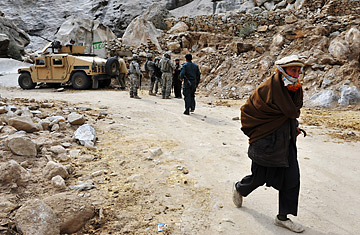
An elderly Afghan man passes U.S. soldiers on patrol in Nuristan province, Afghanistan, on Feb. 14, 2010
(2 of 2)
But the Taliban and their allies have "a very definite plan" to launch attacks in neighboring Laghman province, Western security analysts say. There, NATO is already handing over security of the provincial capital, Mehterlam, to Afghan forces, and the rest of the province is expected to follow suit next year. If the Taliban can seize Nuristan's western fringes, they'll have a free run from the Pakistani border all the way to Laghman, where provincial officials are already said to be glancing nervously at their unruly neighbor.
There is, it's true, a sense that many local Taliban fighters in Nuristan want nothing more than to remain in splendid isolation. But with "most of the authority and the decisionmaking" in the hands of the foreign fighters operating in the region, according to Fabrizio Foschini of the Afghanistan Analysts Network, a Kabul think tank, there are grander agendas afoot. While the withdrawal of U.S. troops has dampened the insurgency in some respects, it has also given the hodgepodge of global jihadist groups in the region freer rein.
According to one Afghan official, members of the Pakistani Taliban, Jaish-e-Muhammad and other groups alien to Afghanistan are regularly present in Nuristan. Western diplomats say that links between the Afghan Taliban and al-Qaeda are stronger in Nuristan and Kunar than anywhere else in the country — and that Lashkar-e-Taiba, a Kashmir Islamist militant group backed by Pakistan's Inter-Services Intelligence agency, is a growing presence. The group is blamed for the massacre of a party of aid workers in Afghanistan's Badakhshan province, next door to Nuristan, in 2010.
Earlier in May, an explosion rocked a house in the Nuristani village of Chatras, killing two Arab fighters thought to belong to al-Qaeda, two retired Pakistani soldiers, three local Talibs — and the 12-year-old boy they were drilling in the craft of suicide bombing. "After the instruction, they fitted the jacket on him," the Afghan official told TIME, "And he said, 'O.K., should I walk like this?' 'Yes, yes.' 'And I should press this button?' And he pressed the button and exploded."
The influx has brought its own problems, with clashes between local Taliban commanders and die-hard outsiders. In a stark illustration of the tension, a Lashkar-e-Taiba commander called Maulawi Ahmad last winter ambushed the shadow governor of Nuristan, Jamil Rahman, who is Zahir's boss. Rahman had publicly upbraided Ahmad for kidnapping engineers working on a road that would improve life for local communities. Ahmad's men reportedly beat Rahman with sticks until they broke his arm. Many foreign militants flowing into Nuristan continue to see such foreign-aid projects as legitimate targets.
It remains to be seen whether these interlopers from Pakistan will have better luck taming Nuristan's wild valleys than NATO has. But even if they're unsuccessful, the situation — a weak government under siege by local insurgents and tensions deepening between the region's myriad factions and strongmen — offers a sobering picture of what the rest of Afghanistan could look like when NATO leaves.
